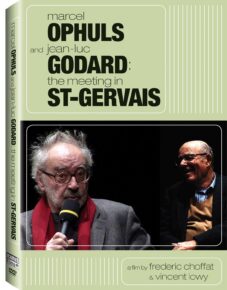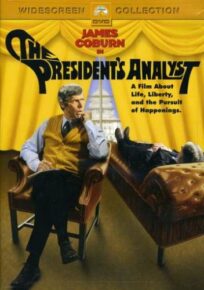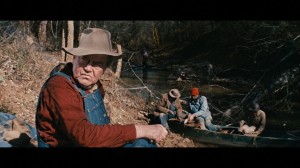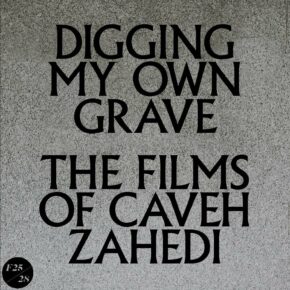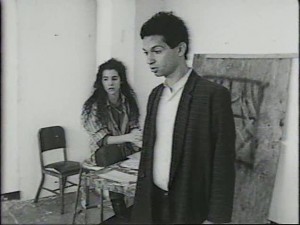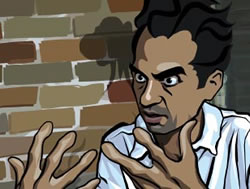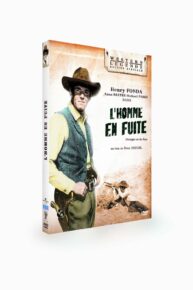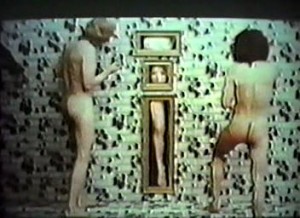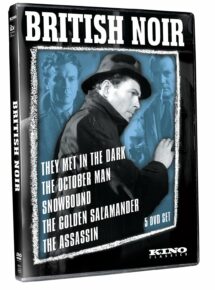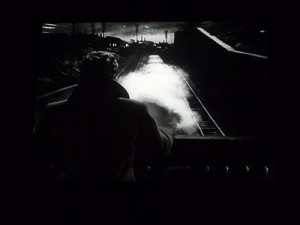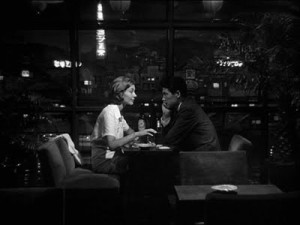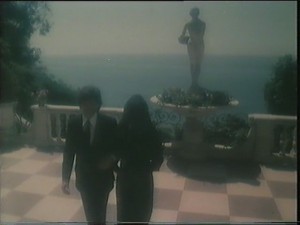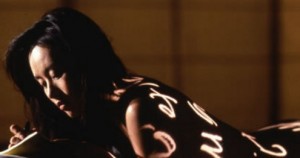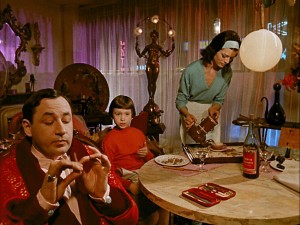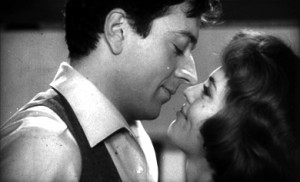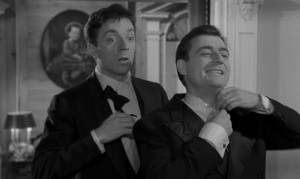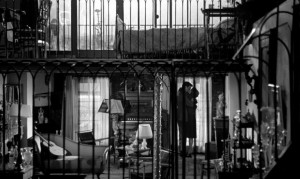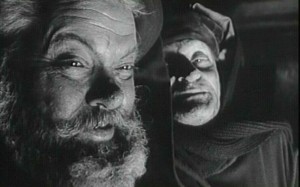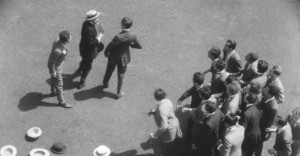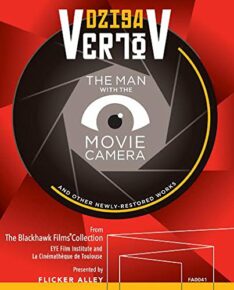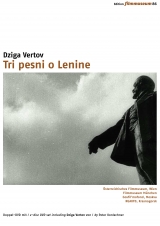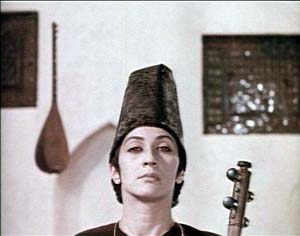My DVD column for the Fall 2015 issue of Cinema Scope. — J.R.
Practically speaking, we should invent our own extras, not necessarily or invariably depend on those that are made on our behalf. To cite four examples of what I mean:
(A) According to normal usage, Icarus Film’s DVD of Frederic Choffat and Vincent Lowy’s 44-minute Marcel Ophuls and Jean-Luc Godard: The Meeting in St-Gervais contains no extras. But according to my own usage, this DVD itself functions as an extra to a 100-page book that I own, Dialogue sur le cinéma: Jean-Luc Godard & Marcel Ophuls, published by Le Bord de l’Eau in 2011. That book, prefaced by short essays by Vincent Lowy and André Gazut and concluded by Daniel Cohn-Bendit’s essay for Le Monde, ‘Mon ami Godard’, transcribes two encounters between Godard and Ophüls, held in 2002 and 2009 (the first of these focusing more on Marcel’s father Max), whereas the DVD includes most (but not all) of the second of these dialogues, and somehow manages to leave out some of the more interesting parts, either through cuts or incomplete subtitles. Which doesn’t mean that Icarus’s release isn’t worth having — only that its contents are worth contextualizing beyond the material offered by Icarus.
(B) There are no extras apart from optional English subtitles on the still-available (and cheap) Paramount DVD of Theodore J. Flicker’s The President’s Analyst (1967) — an intermittently brilliant paranoid satire that, in spite of its Cold War trappings, seems surprisingly up-to-date on such topics as race and surveillance, at least at its beginning and end. (There’s a more conventional, sagging middle section when hippies briefly take over the thriller-farce plot.) This leads me to research my own imaginary bonus feature about writer-director Flicker (1930-2014), whom I erroneously assumed back in the 60s must have made only two features — the first of which was the black and white The Troublemaker (1964), another satire, co-written by Buck Henry and with a Greenwich Village setting, which I barely remember now. But in fact Flicker directed at least a couple of more theatrical features and a great deal for television. He also coscripted (with George Kirgo) an Elvis picture, Spinout, in between The Troublemaker and The President’s Analyst. In short, I wanted to have some notion of who Flicker was, and Paramount couldn’t be bothered, so I had to furnish this sketchy outline myself.
(C) I can’t quite make up my mind about The French Lieutenant’s Woman (1981), out on Blu-Ray from Criterion, but to arrive at a proper critical balance — that is, a proper reflection of my own ambivalence—I need to juxtapose the defense of the film offered by Ian Christie in a video interview (included), which suggests the film is worthy of standing alongside certain contemporary, Continental examples of narrative experiment, with Dave Kehr’s capsule pan in the Chicago Reader (naturally not included) when the film came out: ‘Tasteful, dull, and nearly dead, with all the actors turned into buglike caricatures under the gaze of Karel Reisz’s distorting, entrapping wide-angle lens. The film has been praised for its ingenious solution to the dual-ending problem posed by John Fowles’s novel, yet the cleverness of the solution so dominates the structure that the inherent meanings of the material are reduced for it: the film becomes little more than a tony literary game, at best a retake on the old theme of the actor’s confusion of art and life. And the dual story itself seems a rather simple, inelegant thing, particularly when compared to the kind of narrative experiments conducted 10 or 15 years earlier—in the films of Resnais, Lester’s Petulia, even Ken Russell’s The Boy Friend, which this film comes to resemble to an unholy degree. With Meryl Streep and Jeremy Irons.’
More precisely, I like the film more than Kehr — as a sort of improbable version of Vertigo Meets Masterpiece Theatre, with a dollop of feminist bite–but would make fewer claims for it than Christie does. I certainly retain some skepticism about the common elevation of Pinter (and David Mamet, for that matter) as mercenary screenwriters-for-hire to the ranks of full-fledged, ‘serious’ auteurs.
(D) As a native Alabamian who grew up in the shadow of the Tennessee Valley Authority and Wilson Dam, I believe the ideal extra for Wild River (1960), Elia Kazan’s masterpiece, isn’t the Richard Schickel audio commentary included on the Fox Blu-Ray but a 58-minute documentary by Allison Inman that you may never get to see unless you happen to live in Tennessee — a loving portrait of the impact of the filming on the residents of Bradley and Hamilton counties called Mud on the Stars: Stories from Elia Kazan’s Wild River (2011). Considering how respectful and observant Kazan was about local matters, especially when they were Southern, part of the pleasure to be found here is getting to know the guy who furnished Montgomery Clift with his liquor and the transplanted worker from Cleveland who’s still working on a book about the shoot.
***
The most elaborate set of extras I’ve encountered over the past quarter can be found on the most elaborate DVD box set over the same period, released by Factory 25 (www.factorytwentyfive.com), Digging My Own Grave: The Films of Caveh Zahedi — a package consisting of an illustrated 120-page book, half a dozen DVDs, and a 7” vinyl record that lasts seven minutes. Prefacing the book is a quotation from Raymond Smullyan (‘Most people hate egotists because they remind them of themselves. I love egotists. They remind me of me.’) and a photograph labeled ‘A Portrait of the Artist as a Complete Failure’ which shows Zahedi and his sister with Woody Allen (‘my idol’) on the street in Las Vegas in 1966.
I responded quite favourably to Zahedi’s minimalism in his first feature, A Little Stiff (1990), co-directed with Greg Watkins, included on the first DVD, and to his rap about film theory in Richard Linklater’s Waking Life (2001) — which isn’t included, although Linklater does furnish a blurb to the box set: ‘His body of work at the end of the day will be like a lengthy Walt Whitman poem. It will be a “Song of Myself”. It will be one of the greatest poems ever written, because it applies to everybody.’ I responded less favourably and more bemusedly to I Don’t Hate Las Vegas Anymore (1994), which, along with seven extras, occupies the second DVD, and I Am a Sex Addict (2005), which, along with six more extras, comprises the fourth. And I’m still mulling over the four extras included on the fifth disk to accompany The Sheik and I (2012), which I haven’t yet seen, and the first of the ten shorts on the sixth (I Was in a Film Starring Laura Dern, 1995, about Zahedi’s obsessive rehearsing of an inconsequential line he was asked to deliver in Citizen Ruth). Truthfully, I still can’t make up my mind about Zahedi, whose films tend to charm and annoy me in roughly equal measure, but unquestionably this box set, with fifteen and a half hours of DVD material, is a class act.
***
I recently encountered, for the first time, an odd Don Siegel Western made for TV, Stranger on the Run/L’Homme en fuite (1967), in the excellent, affordable French DVD/Blu-Ray series ‘Western de Légende’, hosted by Bertrand Tavernier and Patrick Brion. (Go to www.sidonis.fr for their already quite hefty catalogue.) It boasts a good many beefy, overlit closeups and an interesting offbeat cast that includes Henry Fonda (as an alcoholic bum), Anne Baxter, Michael Parks, Dan Duryea, Sal Mineo, Bernie Hamilton (the black costar of Buñuel’s The Young One), and Zalman King. The only notable extras here and on other ‘Western de Légende’ titles (e.g., Budd Boetticher’s Horizons West, Delmer Daves’ Broken Lance, Edward Dmytryk’s Warlock, Gordon Douglas’ Rio Conchos, Allan Dwan’s Frontier Marshal, Samuel Fuller’s Forty Guns, Jacques Tourneur’s Canyon Passage) are a choice between French subtitles or French dubbing and impromptu commentaries in unsubtitled French by Tavernier and Brion. (I find Tavernier’s French much easier to follow than Brion’s, and his raps are invariably both knowledgeable and discerning.) I hasten to add that these aren’t audio commentaries, which I can’t recall encountering on any French digital releases; I suspect this practice offends the sensibilities of French cinephiles, who prefer to have their commentaries delivered straight to the camera, with minimal distractions afforded by a brief cutaways to posters, stills, or clips.
It’s tempting to identify Agnès Varda in California, a new Criterion Eclipse set, as all extras and no main course — namely, Uncle Yanco (1967) and Black Panthers (1968) on disc 1, Lions Love (1969) on #2, and Mur Murs (1980) and Documenteur (1981) on #3. It’s a mixed bag any way you slice it, and Criterion hardly helps matters with its confused and confusing printed matter. For the first time, the arch and flippant Lions Love has acquired an even more cryptic subtitle — given as ‘Lions Love…and Lies’ on an added intertitle and as ‘Lions Love (…and Lies)’ on the box — and neither gets explained in Michael Koresky’s pro forma notes, which also make no mention of the film’s cinephiliac cameos (e.g., Carlos Clarens, Eddie Constantine, Peter Bogdanovich), which I find far more enjoyable than Varda’s lazy imitations of Warhol, her awkward uses of Shirley Clarke playing herself, or her expedient appropriations of Robert Kennedy’s assassination and the attempted assassination of Warhol into her makeshift storyline. As for the ungainly subtitle, this turns out to be a slightly subliterate rendering of an early patch of dialogue — ‘Are we really the jungle of lions, love, and lies?’ — which loses all coherence without its commas. Maybe Varda prefers it that way — in which case Koresky should be credited for perpetuating this incoherence, even if he doesn’t get around to explaining it.
***
The title of Fox Lorber’s DVD box set of five features, British Noir, was all that was needed to gain my interest, so I was happy to do without any extras in this case (including even English subtitles, which would have come in handy whenever I had trouble making out parts of the dialogue, meanwhile gratifying my more general desire to treat movies like books to be read, including ones in English). But what does the title British Noir mean, actually? ‘Shadowy thrillers, laced with postwar cynicism’ is what the blurb on the box says, adding that these films all come from the Rank Organisation. But what I value most in the probable gem of the bunch, Roy Ward Baker’s 1947 The October Man, apart from the superb atmospherics of the nighttime cinematography and some of the performances (such as John Mills as the title lead), has nothing to do with cynicism (despite all the anxiety and pessimism implicit in the plot, which Raymond Durgnat rightly associated with Baker’s profile as an auteur). And I’m not even sure that Carl Lemac’s 1943 They Met in the Dark, in spite of its title, has anything to do with noir; it’s mainly an awkward pastiche of a Hitchcock comedy-thriller that isn’t redeemed by having James Mason play its hero.
When it comes to movies that I already love, such as The Fabulous Baker Boys (Twilight Time Blu-Ray), Hiroshima mon amour (Criterion Blu-Ray), Miami Blues (ShoutFactory Blu-Ray), and Some Call it Loving (Etiquette Pictures dual format, region-free), the extras enhance my knowledge and appreciation. Twilight Time offers two separate audio commentaries (one with writer-director Steve Kloves conversing with Julie Kirgo and Nick Redman, the other with cinematographer Michael Ballhaus) and several deleted scenes. Criterion furnishes a slew of new and old extras (including some fascinating comments from Renato Berta about his terrific restoration work on Hiroshima, Peter Cowie’s previously used audio commentary, and two excellent recent interviews with François Thomas and Tim Page about the film’s score, the former of whom proves to be a superb whistler when he has to illustrate a point). ShoutFactory gives us new interviews with costars Alec Baldwin and Jennifer Jason Leigh, and Etiquette Pictures has both writer-director-producer James B. Harris and cinematographer Mario Tosi discussing the (beautifully) restored film and some of the outtakes with Sam Prime.
In the interests of transparency, I should add that I’m mentioned more than once by Harris and Prime, and my championing of Some Call it Loving, which began with 1973 Cannes festival coverage for London’s Time Out and Film Comment, and continued with a longer review in Sight and Sound in 1975 (all this is available at jonathanrosenbaum.net), has now lasted for 40-odd years. I still find this honest, melancholy fantasy about sexual obsession, retarded adolescence, and the loss of innocence spellbinding and outrageously gutsy about its political incorrectness without ever stooping to any sort of exploitation. (It’s an unabashed art movie through and through, and while this and its Cartesian sensibility doomed its stateside reception, it undoubtedly helped it to receive many accolades in France.) And the main revelation of the outtakes, which clumsily try to create a psychological ‘back-story’ for the obsessions of the hero (Zalman King), is how absolutely right Harris was to delete all this material, which would have fatally compromised, diluted, and cluttered the purity of all that remains.
When it comes to movies I don’t much like, or else only half-like, but have decided to resee anyway in case I can change my mind — The Fisher King, Five Easy Pieces, and Day for Night (all Criterion Blu-Rays), The Pillow Book (FilmMovement Blu-Ray), Alain Robbe-Grillet: Six Films, 1963-1974 (BFI Blu-Ray box set), and Zazie dans le métro (Gaumont Blu-Ray) — the role of the extras can be no less important. Terry Gilliam’s enthusiasm for The Fisher King on his audio commentary, which I accessed only after reseeing the film, made me like it somewhat more; Bob Rafelson’s audio commentary on Five Easy Pieces didn’t accomplish that feat, but it did persuade me to resee his follow-up feature, The King of Marvin Gardens (1972), on Criterion’s DVD box set devoted to BBS, and in this case I was won over for the first time — by Rafelson and Jacob Brackman’s daring and original script, by Jack Nicholson’s uncanny but masterful channeling of Wally Cox, by the energy of Bruce Dern and Ellen Burstyn, by many of Rafelson’s unorthodox but poetically apt moves, and by László Kovács’ cinematography — and all these discoveries are assisted and confirmed by the extras on the latter package. I found Day for Night as enjoyably thin as ever, and the wide array of extras from diverse periods does a swell job of situating as well as explicating the film’s real if limited accomplishments — especially the three most recent and most critically poised of these, a video essay by kogonada, a printed essay by David Cairns, and a video interview with Dudley Andrew that effectively complements the other two.
The Pillow Book is already a movie with its own built-in extras, for better and for worse, and Peter Greenaway’s eloquent audio commentary sometimes explains how and why these extras were arrived at better than the film itself does. Alain Robbe-Grillet’s filmmaking is for me something approaching a lost cause, but the best possible case for it, intricately and knowledgeably cross-referenced with his literary work, is offered by Tim Lucas’s expert audio commentaries to all six features, or at least those that I sampled in some detail.
As for Zazie — a film ‘laced with postwar cynicism’, if anything is — it’s difficult for me to think of many works that I feel more divided about. Insofar as it tries to recreate the freedom and joy of silent slapstick, it obviously fails; the freedom may be there, but it’s hard to think of any comedy that’s more joyless and relentlessly antihumanist. But the film is clearly aiming for a lot more than amusement or any sort of spiritual cameraderie, and regardless of what its intentions may (or may not) have been, it’s still a veritable feast for the senses, beautifully restored on this Blu-Ray with optional English or French subtitles. Furthermore, as James Stoller suggested in Film Quarterly at the time of its U.S. release, it’s much closer to being a free-form nightmare than any sort of comedy, with queasy memories of the German occupation leaking out of every pore of its skeptical response to French modernity. Some of these anomalies seem to be covered in the half-hour documentary (unsubtitled) on the Blu-Ray devoted to its making, although I wish more attention had been given to the pivotal role of William Klein (who gets a full-screen credit as ‘artistic consultant’, but is mentioned only once in passing in the documentary; his garish colours and his style of distorting wide-angle close-ups are clearly a basic part of the film’s gallery of grotesquerie, and have a lot to do with what makes this the most visually distinctive of all of Malle’s films.
In a mad splurge, I purchased another Gaumont Blu-Ray release in Paris. a box set containing restorations of four early Philippe de Broca features, Les Jeux de l’amour (1960), Le Farceur (1960), L’Amant de cinq jours (1961), and Un Monsieur de compagnie (1964) — the first three made before de Broca’s entertaining breakout hit, That Man from Rio (1964), the fourth made just afterwards. Truthfully, the driving force behind this extravagant purchase of mine was warm if distant memories of the third of these films, The Five-Day Lover, a bittersweet romantic comedy with faint echoes of René Clair, costarring Jean Seberg and Jean-Pierre Cassel (the latter of whom stars in all the other features on this set), with an unforgettably affecting score by Georges Delerue, I even settled for the fact that the only subtitles included in this package were French ones (‘pour sourds & malentendants’), figuring that this was a good way to spruce up my faulty French.
An interesting and enjoyable aspect of these subtitles, found occasionally on other French releases — and evoking William Faulkner’s projected but never-realized multicolored edition of The Sound and the Fury, designed to clarify all the chronological leaps in the narrative — are their complicated colour-coding: yellow for off-screen dialogue, white for onscreen dialogue, pink for sung dialogue, red for off-screen sound effects or music, blue for voiceover commentary, and green for dialogue in a language other than French.…There are many other extras included, including two de Broca sketches for episodic features—his ‘Gluttony’ for The Seven Deadly Sins (1962) and a period piece with Jeanne Moreau and Jean-Claude Brialy in The Oldest Profession (1967) — and about two hours worth of recent documentary material (none of it subtitled) devoted to de Broca and Cassel, which I wound up skimming.
The Five Day Lover, graced by the lovely sets of Bernard Evein (the masterful art director of Demy and early Godard, Truffaut, and Varda, not to mention Zazie), fully lived up to my warm memories and even went beyond them in the complexity of the four leading characters played by Seberg, Cassel, Micheline Presle, and François Périer. Even the latter, who plays Seberg’s husband and initially registers like a Chabrolian caricature, gradually acquires some genuine density, and if one overlooks the completely unconvincing detail that Seberg’s character is supposed to be English rather than American (which I suspect is an unnecessary carryover from the Françoise Parturier novel the film is based on), this is surely the most complex and interesting character she ever played in a film, comprising a near-definitive statement about how and why adultery is tolerated as much as it is in French life.
This masterpiece clearly stands apart from de Broca’s other work. I found Les Jeux de l’amour (produced by Chabrol, who turns up in a cameo) — a cutesy romp seemingly designed for boorish American tourists — impossible to get through, in spite of some clever sets by the same M. Evein, and Le Farceur, though somewhat more palatable due to the classiness of Anouk Aimée as costar and a quirkier plot (a sort of French variant of You Can’t Take it With You), only slightly better. And the cynicism underlying these two films only becomes more blatant with colour, a much bigger budget, and many more familiar faces (including Catherine Deneuve, Annie Girardot, Sandra Milo, Jean-Claude Brialy, and Marcel Dalio) in Un Monsieur de compagnie. What seems to date all these films and make them seem French to a fault is the ongoing celebration of womanizing and adultery, with female strangers invariably primed to fall into Cassel’s arms the moment he turns up (including even the opening scene in The Five-Day Lover). The Gaumont package dubs de Broca ‘the poet of derision’, and while I can see the derisiveness (including what sometimes seems like contempt for the audience) in all the films apart from The Five Day Lover, I’m less sure about the poetry. But de Broca’s sublime third feature, which I’m happy to say is now gaining a second life in some theatrical screenings, has poetry, subtlety, and insight to spare.
My other extravagant splurge of the past quarter was purchasing all five seasons of The Wire on Blu-Ray from HBO via Amazon; I’m currently working my way through the third season. This also has extras up the wazoo — subtitles in multiple languages and audio commentaries — but I must admit that my level of interest in the commentaries is wholly dependent on my level of interest in the series as a whole, which fluctuates wildly — in contrast to my consistent engagement with all three seasons of Borgen (which have no extras, and don’t need any), the first season of which I covered in my last Winter column. (See photo below.)
For me, the principal problem with The Wire is the feeling of journalistic hipness it constantly projects, which cumulatively fosters a smug sense of sophistication about the way that big-city corruption is said to function in Baltimore. Even when this smugness seems warranted, I question the defeatist sort of self-satisfaction it frequently promotes in the viewer, similar to the cynicism that remains so central to the appeal of the Godfather films. Consequently, I feel divided about the way the audio commentaries often skim over the political meanings of the material to concentrate on the technical skill of the filmmakers (e.g., Michael K. Williams’ terrific performance as Omar Little), oscillating between political analysis and fan-boy stuff that tends to overwhelm it. Similarly, the sheer inventiveness of the inner-city dialogue, which is one of the series’ most impressive qualities, is repeatedly trivialized by the sound-bite editing that’s essential to the formatting of each episode. So I wind up feeling grateful for the audio commentary of Williams in the second season and irritated by the flip confidence of writer-creator David Simon in the third.
Three recent releases from Mr Bongo in the U.K., all without extras: Falstaff/Chimes at Midnight (50th Anniversary Restored Edition, Blu-Ray), The Immortal Story (DVD), Too Much Johnson (Blu-Ray). The first of these, using Luciano Berriatúa’s restoration for the Filmoteca Española, is the most welcome and irreproachable; the other two are more problematical, for different reasons. According to French Welles scholar François Thomas (who has published, in French, a nine-page account of the separate versions of The Immortal Story in Cinéma 013, printemps 2007 — in the third and final part of an exhaustive rundown of the separate versions of Welles’ films, following installments in Cinéma 011 and Cinéma 012), it seems to be the same English-language version released in Italy in 2003 by Ripley’s Home Video (Storia Immortale, which includes provisional but not final edits of the English and French versions plus the latter of these dubbed into Italian; the shorter French version, edited by Welles for French TV but not postsynchronised by him, was released five years ago on a Gaumont DVD.) And Too Much Johnson, incorrectly labeled ‘Welles’ first feature’, does include the 65-minute George Eastman House restoration, but nothing in the packaging even hints that the film is an unfinished workprint (which is acknowledged only in the opening title card). In this case, however, you can alternately download the film for free at www.filmpreservation.org and get all the contextualising extras you need from the same site.
I can’t claim to be any sort of Dziga Vertov scholar, but the pleasure and excitement I’ve gotten from Flicker Alley’s new Blu-Ray edition of The Man with the Movie Camera (1929) — which also includes new Toulouse Cinémathèque restorations of Kino-Eye (1924), Enthusiasm: Symphony of the Donbass (1931), and Three Songs of Lenin (1934), all on the same disk — are mitigated somewhat by the even more scholarly DVD editions of the latter two films available from Editions Filmmuseum in Austria, both two-disk sets. The first of these, Entuziazm (Simfonija Donbassa), offers both restored and unrestored versions, including (among other extras) a 65-minute account by Peter Kubelka of how he resynchronized the sound with the image; the second, Tri pesni o Lenine, includes ‘the earliest surviving versions of Three Songs of Lenin, the 1938 silent and sound reissues, previously unavailable on home video,’ and ‘the two Lenin-themed editions of Vertov’s Kinopravda newsreel series as well as a feature-length TV documentary about Vertov by Austrian Film Museum co-founder Peter Konlechner.’
The recent restoration of Sergei Paradjanov’s Sayat Nova (1969) available on a Rusico DVD offers us three choices in sound — Armenian mono (original), Armenian 5.1, and Russian 5.1 — and subtitles (Russian, English, and French). The extras include Levon Grigoryan’s half-hour Memoires of Sayat Nova and a ‘photo album’ called ‘In Memory of Sergey Paradzhanov: Film & Collage’ — but not, alas, the Paradjanov extra I’ve been endlessly waiting for: the last film he shot, a fragment called Confession, in some ways my favourite of all his works, that has so far appeared only in a documentary that apparently isn’t available digitally, Mikhail Vartanov’s Parajanov: The Last Spring. (One difficulty in researching this matter is the variant spellings of Paradjanov’s name, three of which are found in this paragraph.) Meanwhile, for a scholarly comparison in 2010 between four versions of Sayat Nova that are digitally available, complete with framegrabs, go to www.jamesmsteffen.net/2010/10/the_color_of_pomegranates_on_dvd/

